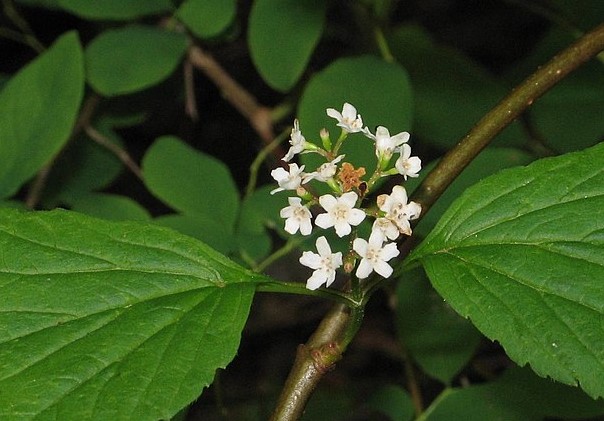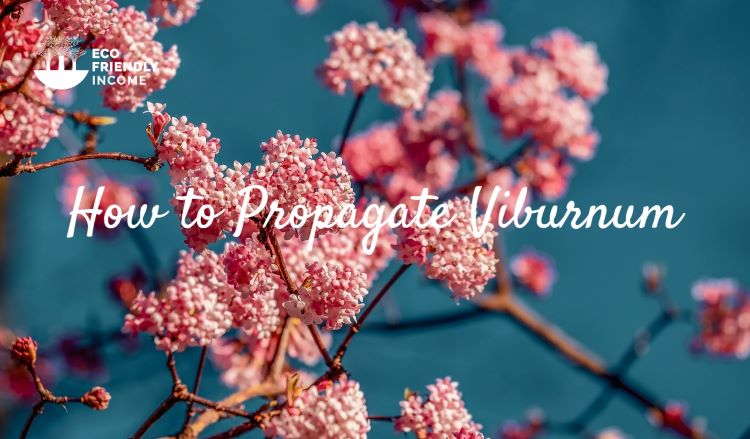
Featured Photo by Dave Powell / CC BY 3.0 US
A field guide on how to identify and propagate Mooseberry (Viburnum edule), a hardy shrub that is native to eastern North America.
How to Identify Mooseberry (Viburnum edule)
Leaves

Mooseberry leaves are elliptical-shaped and can be either unlobed or 3-lobed. Their leaf margin is serrated and they grow on the stems in opposite arrangements.
Fruit

Mooseberry fruits start out pale as seen in the photo, but turn bright transluscent-red when mature. The fruits grow in branched clusters at the extremities of the branches.
Flower

Mooseberry flowers are small, and white and have petals fused at the base that forms tubes with 5 lobes each.
Flowering Season
You can typically see mooseberry in bloom from late spring to early summer.
Fruits typically ripen by late summer and are ready for harvest in early fall.
Habitat
Mooseberry is native to the boreal ecoregions of North America.
You can find mooseberry in moist woods or forests, along the margins of streams or lakes on gravel or rocky banks, and on the margins of swamps or bogs.
Some other understory plants that associate with mooseberry are:
- Raspberries (Rubus spp.)
- Currants (Ribes)
- Lingonberry (Vaccinium vitis-idae)
- Labrador Tea (Rhododendron groelandicum)
- Wild Rose (Rosa acicularis)
- Hazelnut (Corylus cornuta)
Wildlife Value
Many small mammals and songbirds consume Highbush cranberries.
The berries are also eaten by game birds such as spruce grouse and ruffed grouse.
In addition, the foliage is browsed by beaver, rabbit, and snowshoe hares.
How to Propagate Mooseberry (Viburnum edule)

Hardiness Zone: 2-8

Soil Type: Moist, Well-drained Clay, loam, sand.

Water: Normal.

Exposure: Full Sun to Heavy Shade.
You can propagate mooseberry with two effective methods:
- Stem Cuttings: These provides established trees faster, but can be tricky for a beginner.
- By Seed: The success rate is high but takes longer to get established saplings.
How to Propagate Mooseberry (Viburnum edule) by Seed
You can propagate mooseberry by seed if you mimic its natural process, which means a warm-cold stratification is required.
If you can’t find mooseberry growing nearby, you can order the seeds online at Sheffields.
Seed Harvesting Season: The best time to harvest mooseberry fruits is as late as possible during early fall.

Stratification: Mooseberry (Viburnum edule) requires a warm/cold stratification period of 120 days warm, and 90 days cold.
Sowing Depth: Sow the viburnum seeds in the spring, under 1/4″ of fine starter soil.
How to Propagate Mooseberry (Viburnum edule) by Cuttings
Since seeds take so long to germinate, the best way to propagate viburnums such as mooseberry is by rooting semi-hardwood cuttings.
Harvesting Season for Cuttings: Harvest them at least 6 weeks after the first leaves of spring.

- Cutting length: Each cutting should be 4-5 inches long.
- Rooting Soil: The best rooting medium to propagate mooseberry in is coarse sand.
- Duration: Roots take the whole summer to develop.
- Wintering: Bring cuttings in to overwinter or leave them under the cover of snow.
- Transplant Time: Re-pot the cuttings in a good compost/soil mix when they awaken the following spring.
The final step is to add some slow-release fertilizing granules and water regularly. You can place the cuttings in a sunny location.
Mooseberry is a species of viburnum, and they all propagate in a similar way.
If you want a better step-by-step guide on how to propagate viburnum, take a look at our parent article:

FAQ
A: Yes, you can eat them, but they don’t hold much flavor, and have a slight soapy taste.
A: Mooseberry also goes by the names of squashberry, and soapberry.
A: They are native to the boreal ecoregions of North America.
A: To re-pot your viburnum, we recommend using rich organic soil that’s a mix of peat, sand, and compost.
